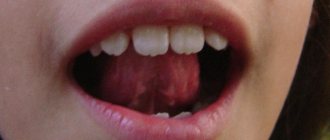Unfortunately, even parents who are not privy to medical subtleties are familiar with the opinion that a short frenulum of the tongue in a child is the cause of speech therapy problems.
Why "Unfortunately"? Because it is ignorance of the material that leads to a clear decision - the bridle needs to be trimmed! Do you remember in the film “Pokrovsky Gate” the characteristic female surgeon with her famous phrase “Cut!.. without waiting for peritonitis”? So the same thing often happens to the poor bridle. However, as experience shows, there is not always only one way out. Not every case of the so-called “short frenulum” requires radical measures.
What is a short frenulum of the tongue?
The frenulum is a thin partition that connects the tongue and the lower oral cavity. Normally, the frenulum is quite elastic, stretches well and is attached to the tongue in its middle part.
An abnormal structure may be the location of the frenulum closer to the edge of the tongue or even at its tip. In addition, a significant decrease in its elasticity, that is, its ability to stretch, is possible.
So in fact, the concept of “short bridle” is not entirely correct. Therefore, there is no clear solution to this issue.
What is the problem with the incorrect structure of the frenulum of the tongue?
In infants, an abnormal frenulum structure can cause difficulty sucking. In this case, the problem is solved in the maternity hospital by pruning. If the baby is still able to eat normally, doctors try to leave the situation alone, giving, as they say, time to grow. Indeed, in many cases, along with the growth of the jaw, the frenulum gradually stretches and takes on a normal shape.
In older children, a short hyoid frenulum creates some speech therapy difficulties:
- Difficulties arise with the pronunciation of hissing sounds.
- Correct reproduction of sonorants is not possible.
To pronounce the so-called upper lingual sounds, you need to raise the tip of your tongue upward. An insufficiently elastic bridle prevents this from being done.
However, it is very important to understand that it is not “responsible” for all speech problems. So if a child has a delay in speech development, syllables and sounds are “confused” in speech, a limited vocabulary or other problems, a short frenulum has nothing to do with it. The speech therapist will suggest effective methods of correction.
How to check if a child has a short frenulum
The presence of difficulties with the frenulum can be easily determined independently:
- Open your mouth slightly and place the tip of your tongue in the area behind your upper teeth. In this position, the place of attachment of the frenulum is clearly visible. If it is not “where it needs to be,” it is difficult to lift the tongue up.
- Pull your tongue forward. A short frenulum does not allow this to be done; in addition, the tip of the tongue visually looks forked
- Open your mouth and try to touch your upper lip with your tongue and lick it. Difficulties with the bridle make this movement difficult to perform.
Please note: sometimes a child cannot cope with these exercises not because there is something wrong with the frenulum. The cause may be weak muscles of the articulatory apparatus. Take a clean handkerchief and try to help your tongue. If resistance is felt when moving, then the problem is still in the hyoid frenulum.
Hyoid frenulum: trim or stretch?
The sublingual frenulum is a membrane that is located under the tongue and connects the tongue to the sublingual space.
How to determine whether the hyoid frenulum is long enough?
The hyoid ligament (frenulum) can be of different lengths in different people. Ask your child to lift his tongue up toward the hard palate. With a normal length of the hyoid frenulum, the child freely raises the tongue to the hard palate. With a short hyoid frenulum, the child cannot stretch the tongue forward and lift the tongue up to the hard palate. When the child pulls his tongue up, you will see how the hyoid ligament, limiting the rise of the tongue, stretches, becomes more pronounced, protrudes more prominently under the tongue, and becomes thinner.
Another reason that a child cannot lift his tongue up is that the child’s tongue muscles are not strong enough and are inactive. Then you will see how he cannot cope with his muscles, then the tongue trembles, deviates to the side, twitches, and falls down.
Normal: at 5 years of age, the frenulum in a stretched state should be at least 8 mm. The average length of the frenulum is 1.5 cm.
What does this mean?
Short hyoid frenulum:
- may cause difficulty in moving the tongue, as it does not allow it to rise high. In this case, the so-called “upper sounds” suffer, i.e. the pronunciation of sounds such as Ш, Ж, Ш, Ш, Р, Рь is disrupted;
- can lead to a displacement of the center of the tongue, its asymmetrical development and low mobility, which prevents the formation of the correct articulatory posture of some sounds;
- may also cause problems with sound pronunciation;
- in some cases, it can provoke problems with the formation of the lower jaw, i.e. The teeth may deviate and the necks of the teeth may become exposed. There is a risk of developing periodontitis and gingivitis. Therefore, a consultation with an orthodontist is necessary.
What to do?
1. Surgery
2. Stretching the hyoid frenulum
Even if the frenulum is somewhat shortened (equal to 8 mm), it is better to stretch it than to operate, since this procedure is somewhat painful and unpleasant for the baby!
Strong indications for trimming the hyoid frenulum:
1. It is better to trim the short frenulum of the tongue at an early age, up to one year.
Indications for surgery if the child while feeding:
• the child sucks poorly at the breast due to the fact that the shortened frenulum prevents the mother from tightly clasping the nipple;
• throws back his head;
• smacks and cries when sucking.
2. At an older age, the indication is when, due to a shortened frenulum, the child’s dentition shifts and an abnormal bite is formed.
3. Difficulties in pronouncing sounds; only in some cases does it require surgical intervention.
In 90% of cases, when 1-4 sounds are violated, the short frenulum of the tongue is easily stretched with the help of special articulatory gymnastics exercises.
Methods and techniques to stretch the hypoglossal ligament (frenulum)
MECHANISM OF EXERCISES for stretching the frenulum: since this is a fold (like a muscular one), a mucous fold, that is, it is possible to carefully and slightly correct the initial state of the frenulum, the exercises give the tongue the opportunity to rise up, thereby gradually stretching the muscle (it is quite elastic), these exercises It cannot be performed jerkily, it must be performed very smoothly and slowly.
Sounds that require a noticeable upward movement of the tip of the tongue ([р], [ш], [ж]) are placed after the child’s hyoid ligament is fully stretched.
Sounds ([l], [h], [sch], [t'], [d']) can be started when the frenulum has not yet fully stretched, but there is already some upward movement of the tip of the tongue.
A short frenulum does not interfere with the normal pronunciation of other sounds of the Russian language.
It is recommended to start stretching the frenulum at an early age. All children are recommended to do tongue exercises - this will help avoid a lot of problems at 5-7 years old (talking about pronunciation).
Who to contact for help
Depending on the complexity of the situation, an orthodontist or speech therapist will help you cope with the problem. In any case, it makes sense to first get a consultation to decide what method of correction the child needs.
The dentist will carefully trim the frenulum, relieving the child of discomfort with one movement of his hand. However, recently doctors still recommend leaving surgical intervention as a last resort. An experienced speech therapist will offer a set of exercises and massage to stretch the frenulum.
Experts say that there are not many situations when the hyoid frenulum is absolutely unable to stretch. In almost all cases, a conservative approach achieves results.
Parents can evaluate the pros and cons of different approaches on their own.
Surgical method:
- A quick, radical solution to the problem.
- The operation is performed using anesthesia.
- The healing process takes some time and is uncomfortable.
- Dietary restrictions due to surgery.
- It is advisable to maintain vocal rest for several days.
- Psychological trauma in the child is possible.
- After the operation, classes with a speech therapist are necessary to correct sound pronunciation.
Frenum stretching method:
- Conservative, does not cause psychological difficulties in the child.
- Effective in most cases.
- Does not require changes to your usual routine.
- It takes some time (several months).
- Requires discipline and regular practice.
In any case, to resolve the issue, you need to consult a speech therapist.
Techniques for making the sound “R” with a shortened frenulum of the tongue
Among all the sounds, in my opinion, the production of the sound p is the most difficult and also the most time-consuming work.
It takes me from 1 month to 1 year. It is especially difficult to work with [p] when the child has dysarthria or a shortened frenulum. During the 4 years of my work in Minsk and Zaslavl as a speech therapist, the most difficult case I had was the production of the sound r with a shortened frenulum. So the girl had a hyoid frenulum about 7 mm long. And if the sounds of the upper rise, for example, [c], [sh] can be placed when the hyoid frenulum is not fully stretched, and normally it is about 1.5 cm, then the sound p requires complete “freedom” of the tongue.
It’s good when parents notice a problem in a child aged 0 to 1 year in time, then it is simply cut off and, as a rule, there are no problems with sounds, but very often attention is paid to this problem during the period of formation of the sound culture of speech (3-4 years old and the child does not make some sounds. However, not in all cases you should contact dental surgeons and trim the child’s tongue frenulum, since this procedure is somewhat painful and unpleasant for the baby. There are certain methods and techniques to stretch the hyoid ligament (frenulum). I have been using it for 4 years and it is quite effective.
However, certain rules must be observed when performing exercises, as well as when making sounds.
Rules for performing exercises
(according to M.A. Polyakova [6]):
1. When performing exercises, the mouth should be opened as wide as possible, but at the same time so that the child can reach the alveoli with the tip of the tongue.
1. All movements should be performed slowly, with a smile, close to the limit of what is possible.
2. Keep in mind that doing exercises is physically difficult for a child, the tongue may get tired, the hyoid ligament may hurt - give him rest.
Rules for making sounds with a short frenulum
(M.A. Polyakova [8])
- Sounds that require a noticeable upward movement of the tip of the tongue ([р], [ш], [ж]) are placed after the child’s hyoid ligament is fully stretched.
- Sounds ([l], [h], [sch], [t'], [d']) can be started when the frenulum has not yet fully stretched, but there is already some upward movement of the tip of the tongue.
- A short frenulum does not interfere with the normal pronunciation of other sounds of the Russian language.
Articulation exercises for stretching the frenulum of the tongue
(E.M. Kosinova [4], E.N. Krause [5], O.A. Novikovskaya [7]):
"Painter"
Smile, open your mouth. Using the wide tip of your tongue, stroke the palate from the teeth to the throat. The lower jaw should not move.
It's time to paint the rooms.
A painter was hired.
We lower the jaw lower,
We help the painter.
"Horse"
Smile, open your mouth. Click the tip of your tongue like a horse clicking. The mouth is open, the tip of the tongue is not extended or pointed. Make sure that it does not tuck inward and that the lower jaw remains motionless.
Let's go, let's go on horseback
The path is smooth.
A neighbor invited us to visit
Eat sweet pudding.
We arrived at lunchtime
And the neighbor is not at home. "Fungus"
Smile, open your mouth. Suck your wide tongue to the roof of your mouth. This is the cap of the mushroom, and the hyoid ligament is the stalk. The tip of the tongue should not turn up, the lips should be in a smile. If the child is unable to suck his tongue, then he can click his tongue, as in the “Horse” exercise. Clicking trains the desired movement of the tongue.
I stand on a thin leg,
I stand on a smooth leg,
Under the brown hat
With velvet lining.
"Harmonic"
Position the tongue as in the “Mushroom” exercise, lips in a smile. Without lifting your tongue, open and close your mouth.
I play the harmonica
I open my mouth wider,
I'll press my tongue to the roof of my mouth,
I'll move my jaw lower.
"Drum"
Smile, open your mouth. Repeatedly and clearly pronounce the sound D-D-D. When pronouncing this sound, the tongue rests on the upper teeth, do not close the mouth. Very often, when performing this exercise, the child closes his mouth. To prevent this from happening, you can hold a stick about 1 cm wide or the handle of a rectangular children's toothbrush between your teeth (the handle should not be thick, it should be straight, like a ruler).
We beat the drum hard
And all together we sing:
“D—d—d—d!”
"Swing"
Smile, open your mouth. On the count of “one-two”, alternately rest your tongue on the upper and lower teeth. The lower jaw is motionless.
I swing on a swing
Up and down, up and down.
I'm rising higher and higher
And then - down.
"Reach your nose"
Smile, open your mouth. Raise the wide tip of the tongue towards the nose and lower it towards the upper lip. Make sure that the tongue does not narrow, and that the lips and lower jaw are motionless.
"Football"
Close your mouth, press the tip of your tongue against one cheek, then the other, so that balls are inflated under the cheek.
"Kitty"
Put a little condensed milk (sour cream, jam) on a saucer and invite the child to lick it with his tongue like a kitten. You can also lick the ice cream.,
“Mushroom” with elements of self-massage
Suggest doing the “Mushroom” exercise. The child himself rubs the frenulum with his thumb and forefinger.
Mechanical assistance when performing articulation exercises
If the tongue sags, the child cannot perform the “Horse”, “Mushroom” exercises, then for proper stretching, the speech therapist takes a probe (“comb”) and lifts the tongue or “swings” it on the “comb”.
Tongue frenulum massage
Using the thumb and index finger of your left hand, grasp the tip of your tongue and lift it up.
The mouth is open.
Using the index finger and thumb of your right hand, use a stretching motion to slide along the frenulum of the tongue from bottom to top.
*****
Stretching the frenulum
• Reception of E.V. Novikova [6]
Rice. 1. Technique for stretching the frenulum according to E.V. Novikova (a)
Rice. 2. Technique for stretching the frenulum according to E.V. Novikova (b)
Having placed a sterile scarf (napkin) on the tongue, place the index and middle fingers under the tongue, frenulum between the fingers, press the thumb on the front of the tongue and perform pulling movements of the tongue outward.
The index and middle fingers are motionless (see Fig. 1 and 2).
Exercise "Mole"
Reception N.G. Vodovozova [8]-
Use your index fingers and thumbs to pull your tongue down by the tip.
- There is a slide in the yard, -
Use your index fingers and thumbs to pull your tongue upward by the tip.
— There is a mink under the hill. –
With your index finger, forcefully stroke the hyoid frenulum from bottom to top, stretching it.
- In this hole
— The mole is guarding the mink.
Exercise with a rubber ring.
(F.Ya. Khoroshilkina [9])
Place a rubber ring (cut from a pipette) on the tip of your tongue. The child opens his mouth wide, pressing the ring with the tip of his tongue to the palate, then closes it. After mastering the exercise, repeat it 3 times a day, 10 times.
Literature:
1. https://www.logolife.ru (article by Chervyakova N.A. “Methods and techniques of working with children with a shortened hyoid ligament (frenulum))
2. Arkhipova E.F. Speech therapy massage for dysarthria. - M., 2008.
3. Vodovozova N.G. Speech therapy massage of the lingual muscles with speech accompaniment // Speech therapist. – 2009.- No. 2.
4. Dyakova E.A. Speech therapy massage. - M., 2005.
5. Kosinova E.M. Speech therapist lessons. - M., 2003.
6. Krause E.N. Speech therapy. Speech therapy classes with children of early and younger age. - St. Petersburg, 2005.
7. Novikova E.V. Probe massage: correction of sound pronunciation. - M., 2006.
8. Novikovskaya O.A. Speech gymnastics. - M., 2008.
9. Polyakova M.A. Self-instruction manual on speech therapy. Universal guide. - M., 2007.
10. Khoroshilkina F.Ya. “Orthodontics” Medical Information Agency M., 2006.









![Producing the sound [L] to a child in stages. Articulation gymnastics, speech therapy exercises, pronunciation lessons with pictures](https://doktorobrubov.ru/wp-content/uploads/postanovka-zvuka-l-rebenku-poetapno-artikulyacionnaya-gimnastika-logopedicheskie-uprazhneniya-uroki-330x140.jpg)
